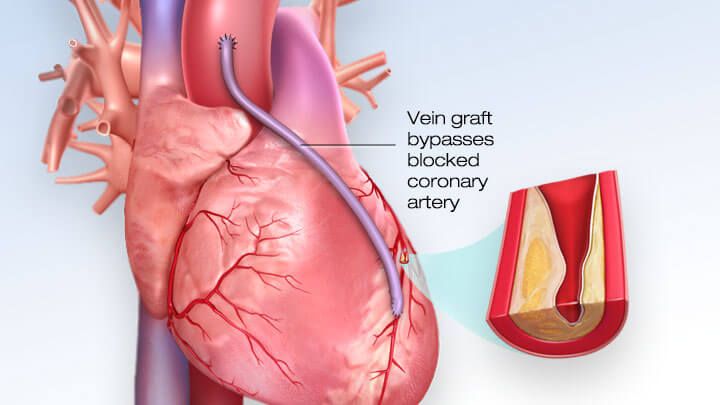Did Your Doctor Recommended Coronary artery Bypass Surgery ?
If your doctor has recommended that you should have coronary artery bypass surgery, have you wondere what does that actually means?

About Heart Circulation
Your heart is located in the centre of your chest and protected by your breastbone and rib cage. It’s hearts job is to keep blood continually circulating throughout your body. Blood vessels that supply the body with oxygen-rich blood are called arteries. The vessels that return the de-oxygenated blood to the heart are called veins.
The heart is a muscular organ, and like any other muscle in the body the heart depends on a steady supply of oxygen rich blood for proper functioning. The arteries that carry this blood supply to the heart muscle are called coronary arteries, and they usually lie on the surface of the heart.
Sometimes these blood vessels can narrow or become blocked by deposits of fat, cholesterol and other substances collectively known as plaque. Over time plaque deposits can narrow the vessels so much that normal blood flow is obstructed.This can cause the heart muscle that lies beyond the location of the artery obstruction to start to die. This fallout precipitates in heart attacks.
How does Coronary artery bypass surgery work?

Coronary bypass surgery attempts to correct this serious problem in order to restore normal blood flow.Before the operation you will undergo a detailed counselling by the surgeon, explaining what the procedure will entail and what the risks are. Admission to the hospital is typically a day before the procedure, with multiple tests and possible medications administered. On the day, you will be asked to put on a surgical gown, you may receive a sedative by mouth and an intravenous line may be put in. You will then be transferred to the operating table for general anaesthesia and prepared for the actual operation. The operating team will include a team of surgeons, anaesthesiologists, assistants, nurses and technicians.
Conventional heart bypass surgery would be done through a sternotomy incision, whereby the breastbone and underlying tissue layers are cut open to expose the heart itself. This incision is typically 8 inches long. The surgeon removes a portion of the blood vessel from the patient's leg or chest (most likely the left internal mammary artery and the saphenous vein). This vessel is then used to bypass the specific location(s) of the blockage in the coronary arteries, thus creating a new pathway for the blood to flow.

These transplanted vessels are called grafts and depending on your condition your surgeon may need to use more than one coronary artery bypass graft.
Of course operating on the heart is a complex and delicate process and your doctor sometimes the surgeon may need to temporarily stop your heart before installing the graft.
At other times, the surgeon may operate on a beating heart also, only holding the specific small portion of the heart surface static while operating. If however this is not possible due to various clinical reasons, A special machine called a heart-lung machine will take over the job of circulating and oxygenating your blood, allowing for the heart to be stopped. By using this machine your doctor is able to repair the heart vessels safely without stopping with the blood flow to the rest of the body. When a patient is put on a heart-lung bypass machine, they're usually given heparin (that acts as a blood thinner) so that the blood doesn't clot in the tubing of the machine.
Following surgery, your heart will be restarted and you will be disconnected from the heart-lung machine.
Detailed procedure of bypass surgery
- In the operating room a nurse will begin the preparation by shaving the chest area and the part of the body from which the graft vessel or vessels will be removed.
- The anaesthesiologist will begin to administer general anaesthesia by injection and inhalation mask. The surgeon will then apply an antiseptic solution to the skin and place a sterile drape around the operative site.
- One or more sections of blood vessel will be taken from the leg, thigh or chest wall and the incision at those points will be sutured and bandaged.
- Your doctor will make a vertical incision in the centre of the chest skin and other underlying tissue will be pulled back in order to expose the breast bone.
- Your doctor will carefully divide the breast phone and a special instrument called a retractor will be used to hold the chest open.
- Once your doctor has a clear view of the heart chamber, he or she will make an incision in the pericardium - a thin membrane that encloses the heart Pulling pericardium back will reveal the beating heart before the graft vessel or vessels can be attached.
- A heart-lung machine may be connected,which takes over the job of circulating and oxygenating the blood so that your doctor will be free to stop your heart for the length of the operation.
- To connect the heart-lung machine one tube is placed into the aorta and a second tube is placed into the right atrium of the heart one or two smaller tubes are then inserted into the heart these will carry a special solution that helps preserve the hearts temperature.
- When all the tubes are in place the surgical team will turn on the bypass machine it will begin to circulate the blood as the heart cools as the cooled blood circulates through the heart.
- Cooling also causes the heart to be at a slower pace. When the temperature of the heart muscle has reached the proper level a clamp is placed on the aorta. At that point blood will no longer flow through the heart and it can be safely stopped and repaired to complete the bypass graft procedure.
- Your doctor attaches the ends of the new vessels on either side of the blocked area or areas of the old coronary artery. Once the grafts have been completed the clamp on the aorta is removed and the heart is allowed to begin beating again.
- As the temperature and the rhythm of the heart slowly return to normal, the heart-lung machine, if used, is disconnected.The pericardium can now be closed over the heart.
- Your doctor will position two special drainage tubes in the chest cavity. These tubes prevent fluid from building up around the heart during the healing process. The breastbone is then closed with metal wire and the remaining tissue layers are closed with sutures. Finally a sterile bandage is applied
How long does a bypass surgery take?
It's based on how the patient's arteries are configured and how many blockages they have. Whether or not a heart-lung machine is needed is also a factor influencing the operation time. Usually, the whole procedure takes somewhere between three and four hours to complete.
How long does it take to recover after the bypass surgery?
Typical stay for patients could range anywhere from 4 to 6 days. There may be a few patients who are ready to leave after three days and that's less common and there might be some patientswho need more time than 6 days. Patients will spend a day or two post-surgery in an intensive care unit. Usually, a day after the surgery, 80 to 90 percent of patients will be ready to move out from the ICU to a regular step-down unit.
After surgery some pain and discomfort is there and some pain management medicine is usually administered to make sure that it's controlled as well as possible. Most people who've had the procedure would say that after a couple days they're very comfortable on just oral pain medicine and they go home. Most patients typically don't need pain medicine after two or three weeks.

Most people who've had bypass surgery they'd say that they still had a little bit of soreness and a little bit of comfort. And that may have continued on for several weeks after surgery. They should typically be back to their normal activities anywhere from 3 to 4 weeks after surgery. Some people are ready sooner and it's usually a couple months through when we do a conventional sternotomy before people can return to all activities including lifting weights and those times.
How common is coronary bypass surgery?
There are at least a hundred thousand heart bypass operations are done each year, though that number has actually decreased.
Improved medications are no doubt helping patients delay procedural interventions for coronary artery disease in some cases, but certainly as people get older and have other diseases like diabetes and hypertension etc. many end up having to undergo bypass surgery. Bypass surgery has progressed quite since the 1970s when it first started becoming increasingly common.
The 1980s brought in important changes like using an internal mammary artery which really has made a difference in terms of the long-term success rate. In the 90s and in this decade, we've seen that the survival rates for bypass surgery being extremely good at nearly 98%, along with good long term outcomes with reasonably good quality of life for recovered patients.
